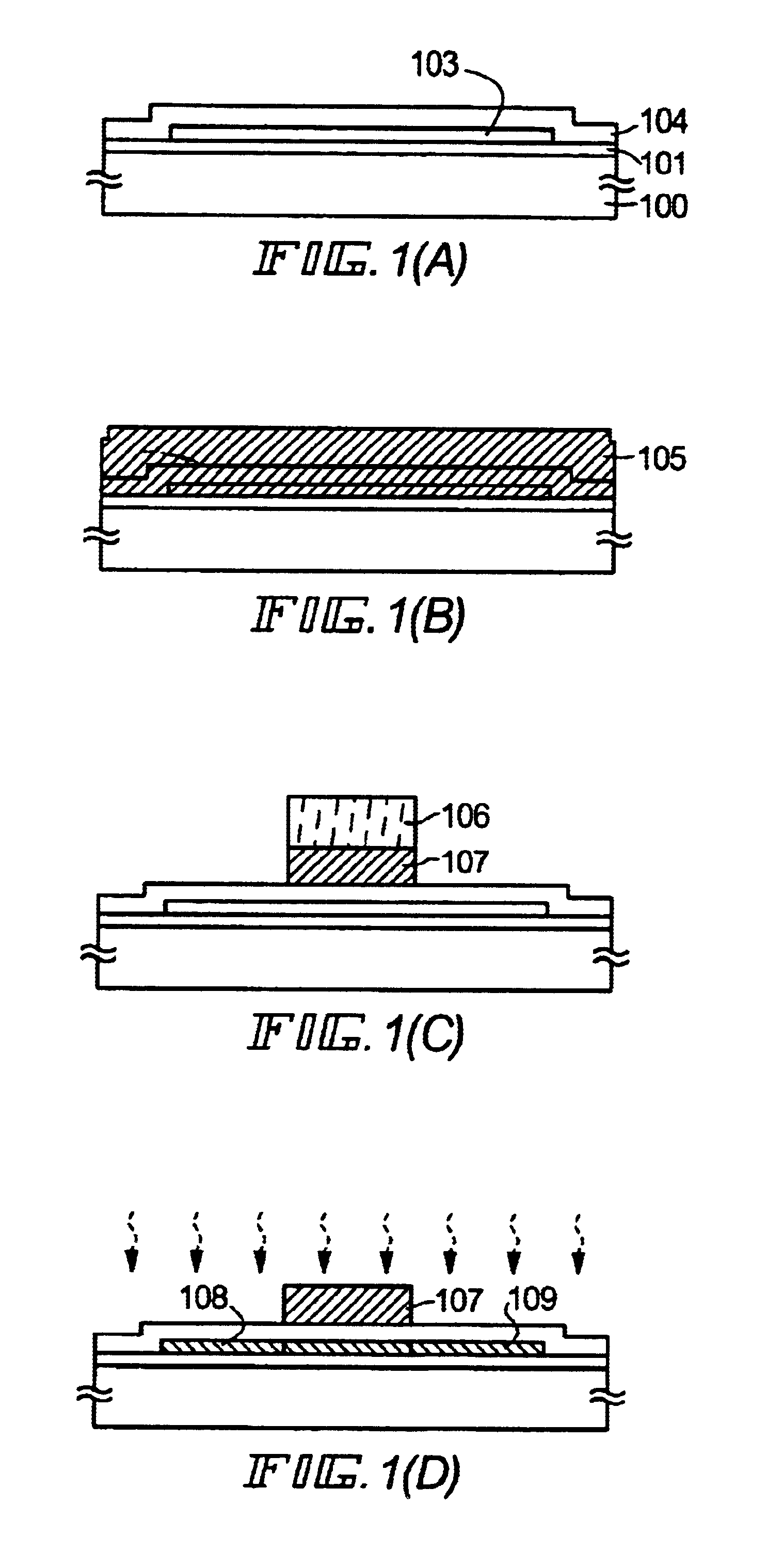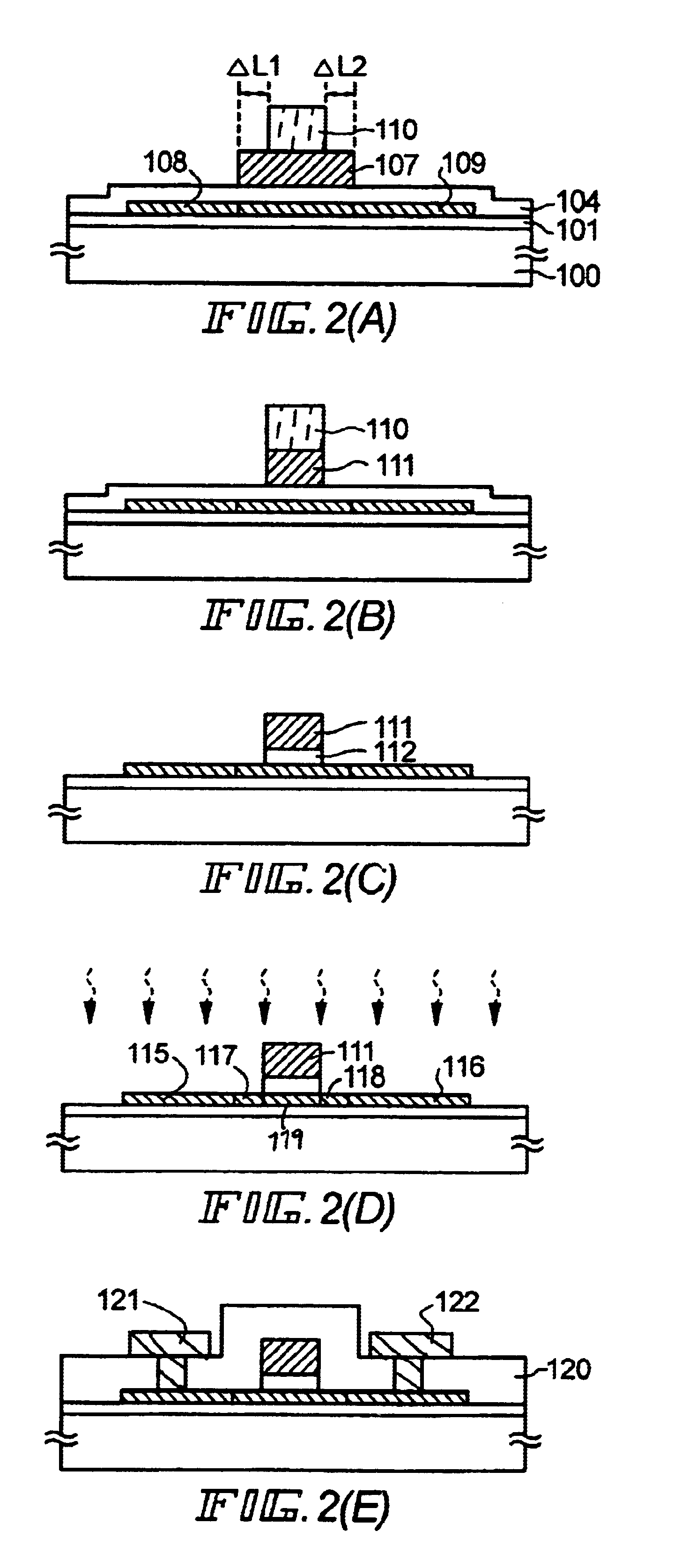Thin film transistor formed on a resin substrate
- Summary
- Abstract
- Description
- Claims
- Application Information
AI Technical Summary
Benefits of technology
Problems solved by technology
Method used
Image
Examples
embodiment 1
[Preferred Embodiment 1]
The present preferred embodiment relates to a manufacturing method of a TFT having an LDD structure. FIG. 1 and FIG. 2 are cross-sectional views showing a manufacturing process and cross-sectional views in the direction of length of the channel of the TFT.
First, an underlayer film 101 is formed on the whole surface of a substrate 100, and an island-shaped semiconductor layer 103 is formed on the underlayer film 101. An insulating film 104 to be a gate insulating film and covering the semiconductor layer 103 is formed on the whole surface of the substrate 100 (see FIG. 1(A)).
A transparent substrate having a transmissivity of 80% or more, more preferably, of 90% or more, to light applied to the back of the substrate (coherent light having a wavelength 400 nm or less), which is described below, is used as the substrate 100. For example, a glass substrate, a quartz substrate, a crystalline glass substrate, and a resin substrate such as a polyethylene terephthalat...
embodiment 2
[Preferred Embodiment 2]
In the preferred embodiment 1, a method of manufacturing a TFT having an LDD structure has been described, and in this preferred embodiment, a method of manufacturing a TFT having an offset structure will be described. The present preferred embodiment will be described by using FIGS. 1 and 2.
In the case of the present preferred embodiment, the impurity adding process shown in FIG. 2(D) is omitted, and in the impurity adding process shown in FIG. 1(D), a high concentration doping is performed at a dose of 1×1015 / cm2 to 1×1017 / cm2 so that the concentration of phosphorus becomes 1×1019 atoms / cm3 to 1×1021 atoms / cm3, thereby sufficiently reducing sheet resistance. As a result, a TFT can be manufactured in which the regions 117, 118 become offset regions.
example 1
The present example is the one applied to a CMOS circuit. The manufacturing process of the CMOS circuit of the present example will be described with reference to FIG. 3 and FIG. 4. FIGS. 3 and 4 are cross-sectional views along the direction of length of the channel of the TFT.
A glass substrate 200 is prepared. In the present example, a 1737 glass substrate made by Corning Glass Corp. is used. An underlayer film 201 is formed on the surface of the glass substrate 200. A silicon oxide film having a thickness of 200 nm is formed by plasma CVD by using TEOS (tetra ethoxy silane) gas as a raw material. The underlayer film 201 is heated at 400° C. for 4 hours.
An amorphous silicon film having a thickness of 500 nm is formed on the underlayer film 201 by plasma enhanced CVD (hereinafter referred to as PECVD) by the use of SiH4 diluted with an H2 gas. A low pressure CVD may be used instead of the PECVD. The amorphous silicon film is heated and dehydrogenated at 450° C. for one hour, whereby...
PUM
 Login to View More
Login to View More Abstract
Description
Claims
Application Information
 Login to View More
Login to View More - R&D
- Intellectual Property
- Life Sciences
- Materials
- Tech Scout
- Unparalleled Data Quality
- Higher Quality Content
- 60% Fewer Hallucinations
Browse by: Latest US Patents, China's latest patents, Technical Efficacy Thesaurus, Application Domain, Technology Topic, Popular Technical Reports.
© 2025 PatSnap. All rights reserved.Legal|Privacy policy|Modern Slavery Act Transparency Statement|Sitemap|About US| Contact US: help@patsnap.com



